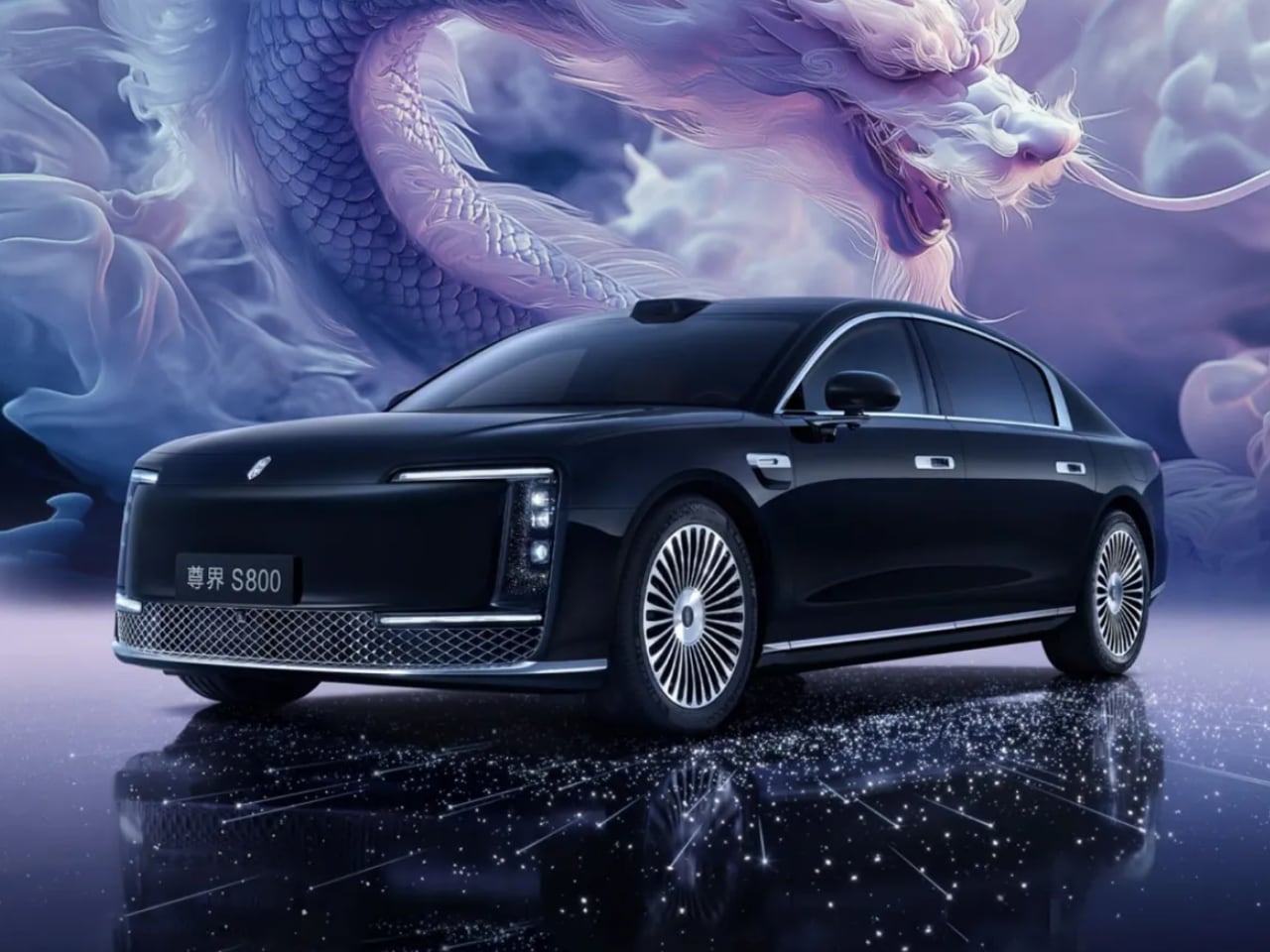The Huawei Maextro S800 represents a design study of how digital technology companies approach automotive creation. Unlike traditional automakers who often begin with engineering requirements, Huawei’s design team started with the spatial experience inside and out. This approach yields a vehicle that questions established automotive design conventions while introducing new possibilities for how drivers and passengers interact with transportation spaces.
Designer: Huawei
The vehicle emerges from a studio process that prioritized form exploration before technical specification. Design sketches reveal an evolution from abstract sculptural studies to the final production aesthetic. This process allowed designers to consider proportions and volumes without immediate technical constraints, resulting in a language distinct from legacy automakers and other EV startups.
As the inaugural offering from Huawei’s Harmony Intelligent Mobility Alliance (HIMA), this full-size sedan transcends conventional benchmarks, offering a blueprint for the future of intelligent, design-forward electric vehicles in the luxury automotive sector.
Exterior Design: Precision in Light and Form
The exterior of the Maextro S800 speaks a design language of restrained futurism. Instead, the front fascia abandons the traditional grille structure, featuring a smooth, sealed surface that enhances aerodynamic efficiency. This surface is a canvas for a subtle light signature that activates upon approaching the vehicle, creating an interactive welcome experience.
Sculptural Proportions with Functional Elegance
Measuring 215.75 inches in length and 78.74 inches in width and featuring a 132.68-inch wheelbase, the S800 commands attention through sheer presence while maintaining aerodynamic efficiency with a 0.22 drag coefficient. The silhouette blends a fastback roofline with an upright front grille that defies wind resistance norms to prioritize visual grandeur over pure efficiency. This design choice reflects a deliberate rejection of minimalist EV trends, instead embracing a “neo-classical futurism” that balances heritage and innovation.
The vehicle’s profile flows from a low, sloping hood into a cabin with generous glass surfaces, culminating in a tapered rear section. This profile enhances range while maintaining visual dynamism. The designers have avoided the temptation of excessive character lines, instead relying on the interplay of surfaces and proportions to create visual interest.
Lighting as an Artistic Medium
Illumination plays a crucial role in the exterior design strategy. The most striking innovation lies in its Milky Way Light System, which transforms functional components into artistic installations:
The headlights feature dual LED light bars flanked by 1,296 micro-LEDs that create a starburst effect, dynamically adjusting intensity based on driving speed and environmental conditions. The taillights employ a multi-layered optical system that projects holographic patterns resembling cosmic nebulae, visible up to 500 meters.
Door handles incorporate fiber-optic strands embedded within flush-mounted surfaces. During the approach, these emit a constellation-like glow, synchronized with puddle lamps that project brand motifs.
Material Innovation and Detailing
The wheel design deserves particular attention for contributing to efficiency and aesthetics. The 20-inch “Celestial Orbit” wheels feature self-aligning center caps that remain upright during motion, achieved through a gyroscopic mechanism typically used in aerospace applications. The intricate pattern optimizes airflow around the wheels while creating a sense of motion even when the vehicle is stationary.
The two-tone paint process employs a proprietary nano-ceramic clear coat that refracts light differently across body panels, creating a chameleonic color shift under varying angles. This signature hue explicitly developed for this model reveals subtle undertones depending on lighting conditions while enhancing durability and providing exceptional depth and richness to the finish.
A roof-mounted LiDAR dome is seamlessly integrated into the greenhouse structure, avoiding the “sensor acne” plaguing many autonomous vehicles while maintaining the clean design aesthetic.
Interior Design: A Biomorphic Tech Sanctuary
Stepping inside the Maextro S800 reveals an interior space designed around human needs rather than technological showcasing. The dashboard presents a horizontal orientation that emphasizes the cabin’s width. Physical controls have been thoughtfully retained for primary functions, acknowledging the tactile feedback that drivers value during operation.
Spatial Design Philosophy
The cabin adopts a “Sixth-Generation Aircraft” concept, prioritizing occupant well-being through forward-slanted A-pillars that increase glass surface area by 28% while maintaining structural rigidity via boron steel reinforcements. A floating console architecture employs a magnesium alloy substructure that suspends the dashboard and center console, creating an illusion of weightlessness while reducing NVH by 15 dB.
Material Selection and Sensory Experience
Material selection throughout the interior demonstrates a commitment to sustainability without compromising luxury. Recycled textiles with sophisticated weave patterns cover seating surfaces, while reclaimed wood elements provide warmth and texture to key touchpoints. These materials create a sensory experience that connects occupants to the physical world in an increasingly digital environment.
Huawei’s Stellar Horizon Interface redefines human-machine interaction through HaptiWave Surfaces—patented metamaterials in door panels and armrests that transmit subtle vibrational feedback corresponding to audio frequencies, creating a tactile soundscape. An Olfactory Control System goes beyond essential air purification with a dual-layer circulation system that releases nano-encapsulated fragrances triggered by biometric sensors monitoring occupant stress levels.
Adaptive Environments and Personalization
The seating design merits special consideration for its ergonomic innovation. The front seats feature a floating design with adjustable support elements that adapt to individual physiology. This approach creates a sense of lightness within the cabin while providing exceptional comfort for long journeys. The Concierge AI embedded in the headrests utilizes millimeter-wave radar to detect passenger preferences, with seat bolsters automatically adjusting firmness based on posture changes detected during cornering.
Through adaptive biolighting, ambient lighting serves both functional and atmospheric purposes. The 8,192 individually addressable LEDs in the starry sky roof simulate natural circadian rhythms, with wavelength tuning from 1,800K (candlelight) to 6,500K (daylight). Thin light elements trace the contours of the dashboard and door panels, providing subtle illumination that reduces eye strain during night driving. These lights respond to various inputs, including time of day, vehicle speed, and music selection, creating an environment reflecting the current driving context.
Market Positioning and Future Vision
While traditional ultra-luxury sedans target inherited wealth, the S800 appeals to Tech Oligarchs—a new class of buyers valuing computational supremacy as much as material opulence. Huawei leverages its telecom infrastructure to offer a 5G-V2X subscription with real-time road conditioning data crowdsourced from Huawei’s global base stations, and Blockchain Ownership Tokens enable NFT-based vehicle titles for fractional ownership models.
The JAC collaboration combines a FlexSpace Architecture—a modular platform supporting wheelbases from 3,200–3,600 mm for future SUV and coupe variants—with a Giga AI Factory that utilizes quantum annealing optimizers to reduce production defects by 0.0001%.
The Huawei Maextro S800 challenges conventional automotive design by treating the electric vehicle as a creative and functional reinvention space. Its exterior aesthetics, interior comfort, and integrated technology reflect a design process prioritizing form and user experience over traditional engineering constraints.
The Maextro S800 doesn’t compete with legacy marques—it establishes a new paradigm where computational density becomes the ultimate luxury commodity. Huawei integrates its ICT expertise with avant-garde design to create a seamless continuum between digital and physical experiences. As traditional luxury metrics give way to processing power and sensor density, the S800 positions itself as a forward-thinking entrant in the high-end automotive space.
The post Huawei Maextro S800: Where Technology Meets Art in Automotive Design first appeared on Yanko Design.

